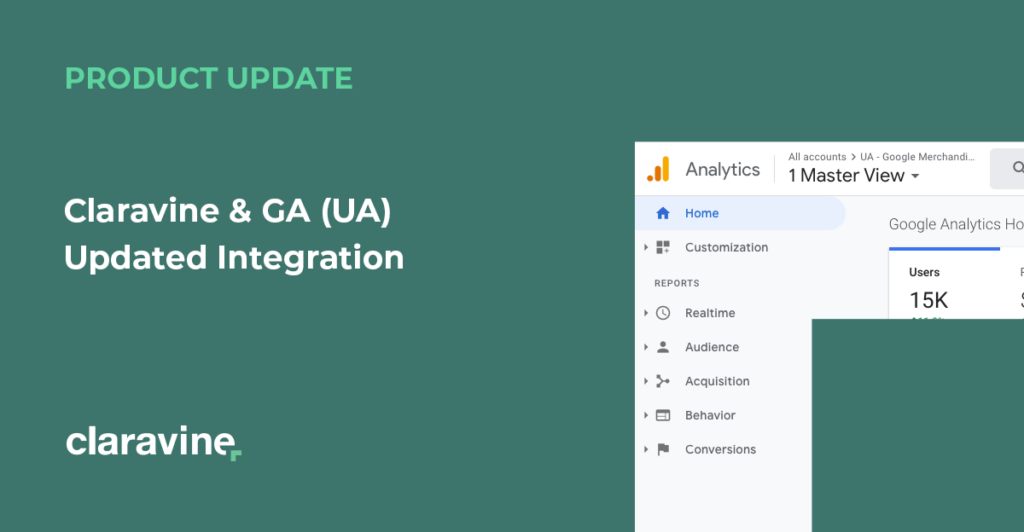Claravine & GA (UA) Updated Integration

The early roots of Claravine when we were known as “Tracking First” were centered around Adobe Classifications, in other words, the ability to expand data in your analytics platform. Fast forward to now, we have more integrations with other platforms in analytics and the cloud, and we continue to make them better. With our updated Google Analytics (GA) integration, we add another layer of data expansion in the form of Custom Data Import capabilities between Claravine and GA.
**Before we continue, it is important to note that this is for GA Universal Analytics (UA). GA4 plans are in development.**
In the current integration, users of Claravine can utilize the Campaign Data Import functionality in GA to send expanded data using utm_id (campaign code) as the join key. For implementation, it’s important to note Google’s documentation on which type of processing one should choose during setup. Most likely the import will be configured as a Processing Time import because most GA users have integrated their platform across the Google Marketing Platform ad tools.
What does having a Processing Time import mean?
It means when a hit is recorded on your site and the utm_id is present in the URL, during the process of that hit, Google will expand the imported data across the mapped dimensions. Note that since these are all session-scoped dimensions, the values will expand across all hits on that session. Also important to note, Processing Time import is not reversible and not historical – this is similar to how view filters work in GA, it permanently alters the data.
Now very likely, that user could come back to your site, and let’s say they have your site window open, but the URL does not have the utm_id in the query parameter – enter Google’s last non-direct session model. Google wants to recognize the previous campaign hits before it credits a user with direct attribution, and since utm_id is a campaign parameter, that value will be recorded in GA during processing on the platform. On the flip side, since utm_id was not part of the actual hit (it was applied because of GA’s data model) – the imported dimension data would not be expanded on the second session.
Not detrimental, you could easily blend data on the stored utm_id key in a BI/data viz tool; however, if you are building audiences or segments with the expanded data, and depending on the build, it could have an impact on other elements within your organization.
So what are the other options? We could utilize Custom Data Import and Claravine can now help with that option.
By using the Custom Data Import feature, GA360 users have the option to utilize the Query Time import feature which allows expansion of historical data and this import type is reversible.
The most important note on Query Time Import, you will have to send your expanded data set independently to Big Query. As the name implies, the data is available on query and not fixed to a hit at processing.
If you are running Adobe Analytics and Google Analytics side by side, this may be the better option as features of Adobe Classifications (historical mapping, any designated custom variable, reversible datasets) work as similar to a GA component as is possibly feasible. If you pass your Adobe recognized query parameter (like cid=something), you can store that value in a Custom Dimension versus using a UTM parameter to mirror the Adobe parameter.
Custom Data Import namely allows you to use Custom Dimensions as a key (among other out-of-the-box GA dimensions) to design a customizable data import unique to your organization. In Google’s words, “The basic concepts, steps and limitations of Custom Data Import are the same as for other import types; however, you have more flexibility in the choice of key and target dimensions.”
Even if you are not using Adobe, there is a case for parallel UA and GA4 implementations. By getting accustomed to Custom Data Import, and with only (4) Data Import options currently available in GA4, this could also offer a way to expand your campaign event parameters and/or user properties in Big Query with the same dataset table you are using in UA.
The last item to consider would be value persistence. If using a session-scoped Custom Dimension as a key, what if we want to persist that value on the next visit similar to how utm_id persists in a last non-direct session hit?
This would be something I would vet out with your team of Analytics Engineers or your Dev team. The bonus with persisting a value, and using that value as a key in your Custom Data Import setup, is that it gives you the ability to apply values historically with Query Time processing – you would have ALL session-scoped metadata expanded on the first, second, third, and so on, visit.
But wait, there’s more…
The above outlines the most typical use cases we see with our GA clients; in addition, the new integration will allow you to use ALL the Data Set types located in GA Data Import feature. This allows you to join Refund, User, Content, Geographical, Content, Product and Cost Data to a number of keys within your GA Platform in an automated way.
All in all, the Google Analytics Integration update offers another option on our flexible platform. If you are thinking, “What is the best use of this integration?” My best recommendation is to give no recommendation and go with the classic analytic response of “It depends…”; however, reach out to us at Claravine, and we will start you on the right path.


